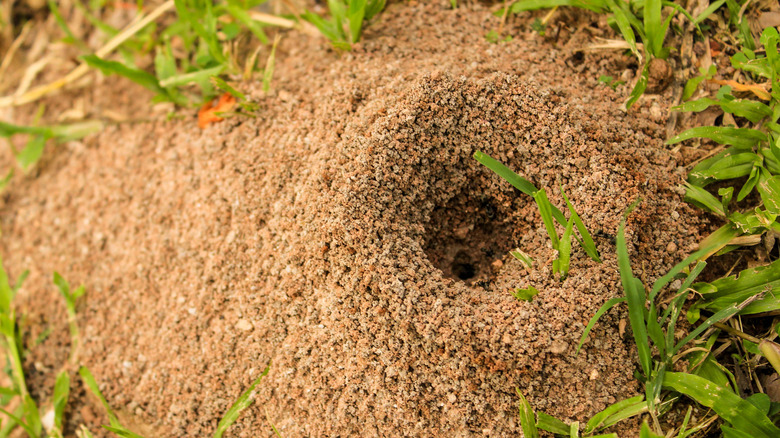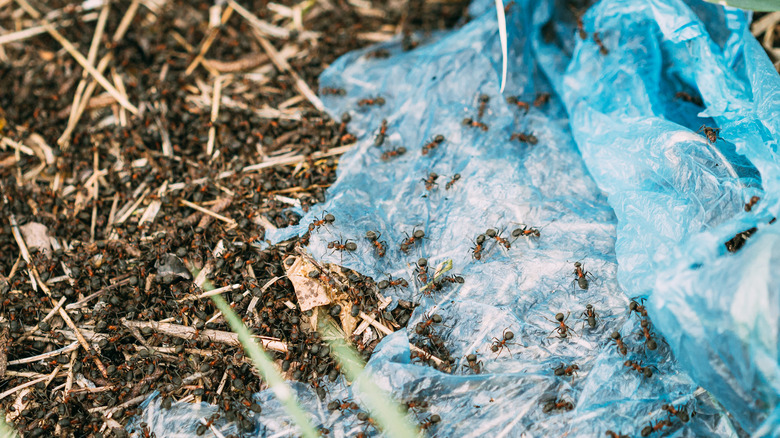8 Tricks To Eliminate Anthills In Your Yard
Nothing interrupts a sunny afternoon enjoying your backyard quite like stepping on an anthill. While most ants are more annoying than harmful, some variations like fire ants can cause serious damage with their aggressive behavior and painful stings. If you've seen these dirt mounds popping up, the good news is that there are many solutions to keep your home's ant population under control.
To eliminate an anthill, it is important to understand how they work. The dirt mound you see above ground is just the tip of the iceberg. Beneath the visible entrance is a whole network of tunnels with pathways, chambers, and exits that house an entire ant colony. Because the inner anthill is so vast, they can be hard to eliminate. But with persistence and a few of the following tricks, you can keep your yard ant-free. From using boiling water to incorporating common pantry staples, you can get to work asap eradicating your problem. Here's how.
Use boiling water for a quick and affordable fix
One of the most straightforward and budget-friendly methods to eliminate an anthill uses only hot water. This practical solution requires nothing more than boiling a kettle of water and pouring it directly into the anthill. The use of a kettle is recommended so that the pouring can be precise, but using any pot of boiled water and a heat-resistant funnel will achieve a similar effect. As the researchers at Texas A&M remind us, it is best to use at least 2 or 3 gallons of water to make sure the anthill is fully flushed out, otherwise it will not kill enough of the ants, and the colony will simply move to another nearby location. This method can be repeated several times or over the source of several days to make sure the ants are fully gone. In all likelihood, you will probably have to perform this trick several times or combine it with another hack on the list, since the researchers note this works about 60% of the time to fully eradicate the colony.
The intense heat will kill any ant it comes in contact with, and the act of pouring water effectively flushes out the intricate network of tunnels, making them unusable for ants to re-inhabit. This dual-action approach not only immediately tackles the ant population, but also disrupts the subterranean infrastructure that allowed them to thrive in the first place. However, if the ant hill is perched on a carefully cultivated plot of grass, you should think twice about using the boiling water method, since the water will kill any grass it comes in contact with.
Pour white vinegar into the anthill
If you need to eliminate an anthill quickly, using white vinegar is a great solution to get rid of pests using only what is found in your kitchen. Simply mix equal parts white vinegar and water, then use a funnel to carefully pour the solution into the anthill. Make sure to create enough vinegar solution so it can reach the deepest parts of the anthill. Consider utilizing 2 to 3 gallons like in the boiling water trick.
This DIY solution is extremely effective because of the ants' relationship to scent. Ants have specialized odor receptors, called antennae, which they use to detect pheromones — chemical signals that convey information to other ants. The use of pheromones is crucial for ant communication to mark paths, signal danger, or identify nestmates. Vinegar has a potent smell that can mask or overpower, interfering with the ants' ability to detect and follow these chemical trails. Additionally, the vinegar smell acts as a natural repellent, creating a barrier which deters ants from coming back to their anthill. Together, this turns the anthill into a place where no surviving ant would want to live.
One thing to note is that this might need to be combined with other hacks to permanently eradicate the ants. The vinegar doesn't necessarily kill the ants — instead, the act of drowning them in the solution is what is killing them. The odor of the vinegar will help deter any surviving ants from returning, but it is only as effective as its scent. That means you will have to keep reapplying the vinegar after it has faded to keep the deserted anthill uninhabitable until your ant problem has cleared.
Spray insecticide for a stronger solution
While using natural solutions is great if you have a child or a pet running around your yard, sometimes fighting an invasion of ants feels like a never-ending battle. In this case, you might need something stronger. If other methods haven't worked, spot-treating anthills with insecticide provides a powerful and permanent solution. Researchers at Iowa State University's Integrated Pest Management Center suggest using an insecticide, such as Sevin from Home Depot. These insecticides are available in liquid or granular solutions. You should always adhere to the instructions on the packaging, but generally, to use an insecticide, you first rake the anthill flat, then sprinkle the granules around the soil, or use the liquid solution to drench the anthill.
While this is a surefire solution to get rid of ants, insecticides should only be used on lawns, landscapes, and vegetable patches but never for ant problems in pastures and prairies. Insecticides are easily available for purchase at any Home Depot, Walmart, or your local home improvement store. However, if the idea of handling chemicals makes you skittish, you can always hire a pest control company to treat the anthill for you.
Sprinkle diatomaceous earth for a non-toxic fix
While diatomaceous earth might sound like a term lifted from a science textbook, it is, in fact, a simple product with numerous household uses. This naturally occurring mineral-based substance is made from the fossilized remains of algae that accumulated over time to form a soft, chalky, sedimentary rock. So, how does this unassuming mineral tackle ant infestations? Diatomaceous earth may appear soft and chalky to the naked eye, but seen under a microscope, it has abrasive and sharp edges. Once you purchase a bag of diatomaceous earth, simply sprinkle it in and around the anthill. As ants move through the powder-filled dirt, the razor-sharp particles scratch and cut their protective exoskeleton layer. If these scratches don't stop the ants in their tracks, the diatomaceous earth also absorbs into their waxy outer layer, causing the ants to dehydrate and eventually die.
This solution directly targets the elimination of the ant population rather than the anthill itself. It is a great solution for those with pets since it is non-toxic to both animals and humans. However, you should make sure to purchase one that is specifically labeled non-toxic, like this Harris Products one available at Walmart. This also might not kill the entire colony, since the ants need to come into contact with it for it to work. Because of that, you might have to combine this treatment with another hack to make it more effective.
Combine borax and sugar for a DIY pesticide
One of the trickiest parts of eliminating an anthill is reaching the furthest depths of the underground colony. However, you can use a combination of Borax and sugar to trick the ants into doing the hard work for you. Borax is a naturally occurring mineral composed of boron, sodium, and oxygen, and while humans typically use it for laundry, it is highly toxic to ants. It disrupts the ants' metabolism, preventing them from properly digesting food, which eventually leads to their death. The substance on its own isn't too appetizing to the insects, so you must mix the Borax with sugar and then place the sweet mixture nearby where the ants will quickly come, thinking it's a bountiful food source.
As Terminix, one of the largest pest control companies in the world, explains, Borax doesn't kill the ants right away. Rather, it has to be digested in order to take effect, which takes some time. This is a good thing, as it allows the worker ants to carry the borax and sugar combination back to the colony, where all of the ants, even the queen, will feed. This is a good solution to try if other methods haven't managed to eliminate all the ants in the deeper chambers of the anthill.
Buy pre-made ant baits
If you don't have Borax on hand or if you want the simplicity of a premade product, then buying an ant bait like these outdoor liquid ones from Terro could be the right choice for you. The process works in the same way as Borax and sugar. The worker ants are attracted to the sweet bait, which, in this case, comes in a liquid form. The ingredients in the bait are designed to kill the ants slowly by interfering with their digestive system, providing enough time for them to bring back the bait to all layers of the colony.
Terro gives a few tips and tricks to make sure the ant baits are used as effectively as possible. To choose the placement of the bait, you should look for ant highways — those long trails of ants that lead back to the colony. By placing the bait nearby, you can ensure that the maximum number of ants will take it back to the colony. The brand warns not to use this method in combination with contact ant killers, like diatomaceous earth, as they may prevent the ants carrying the bait from making it back to the hill.
A premade bait is one of the easiest solutions available, as all you have to do is buy the bait, place it, and then wait. Additionally, many baits are made of plastic, making them weatherproof against elements like rain and wind, so take into consideration the current climate when deciding what solution is right for you.
Leave citrus peels around the anthill
Just finished an orange? Toss that peel next to the anthill to help get rid of pests. This zero-waste solution is all-natural and helps repurpose your discarded citrus peels to stop ants in their tracks. This trick works with lemon, orange, grapefruit — any type of citrus. Simply leave the fresh peels near the anthill and let the ants be attracted to them. As researchers at the University of Florida explain, this trick works because of the acidic oil found in the peel called D-limonene. This citrus oil repels and eliminates ants in two ways. The first is that the D-limonene has a strong citrus scent that disrupts and masks the ants' pheromone trails, similar to how white vinegar works, confusing ants and making it challenging for them to follow established paths. D-limonene also has insecticidal properties. When ants come into contact with D-limonene, it can interfere with their nervous system and respiratory functions, leading to their death.
Because this is an all-natural solution, it is perfect for those with pets or other critters running around their yard since the citrus won't be harmful to most animals. If you need a boost in power, you can skip the orange peels and instead use citrus oil, which will be more concentrated. Mix a gallon of water with a heavy dose of oil, mix it together, and pour it into the anthill. However, if you are dealing with a large or particularly stubborn anthill, you might want to try a solution like insecticide or borax, which penetrates deeper into the colony.
Use this trash bag hack to raise the heat
Summer is the perfect time for hanging out in your yard, but if ants are disrupting your day, it's also the ideal time to eliminate an anthill with nothing but a trash bag and some weights. Simply grab a trash bag and cover the anthill, then use something heavy like bricks or rocks to secure the tarp from blowing away or shifting around. This hack isn't about keeping the ants from escaping, but rather using the trash bag to turn the anthill into a sauna, raising the heat inside the anthill enough to make it unlivable.
Ants only build their colonies in areas where the conditions are suitable for them to thrive, and if you make the environment unwelcoming, they will move out of your yard and find somewhere new for their survival. This hack will also prevent any new ants from being born, as larvae can only live between 75 to 95 degrees Fahrenheit, and after a day or two under the trash bag, the temperature will rise above that threshold. The only caveat to keep in mind is that the ants might simply move to another part of your yard to build a new hill. If they do, you might need to use another hack on this list that more effectively wipes out the entire colony, such as the insecticide.








